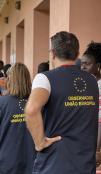EU election observers in São Tomé Príncipe

An essential element of EU election observation methodology is its long-term and comprehensive coverage of the electoral process countrywide. That’s why 10 EU long-term observers have been deployed across São Tomé e Príncipe since 7 September, and they will remain in the field until the beginning of October. Their observation, assessment and reporting is vital to the overall collective assessment of the EU Election Observation Mission.
EU long-term observers work in teams of two and come from different EU Member States. These two criteria are important to enhance the credibility and reliability of their observations and to ensure a balance of analysis. The five teams are deployed in the districts of Água Grande, Mé-Zóchi, Lemba, Lobata, Cantagalo e Caué, while one team is covering the Autonomous Region of Príncipe.
Long-term observers focus their analysis on the regional political context and on the role of parties, lists and candidates in their districts, the same topics that the Core Team in São Tomé follows at the national level.
They observe also the performance of the local election administration in preparing and implementing the elections. They ask about voter registration, assessing the level of public confidence in the quality and accuracy of the voter register, and the candidate registration process at regional level. They also attend rallies and campaign activities.
The observers report to a Core Team of analysts in the capital whether the freedoms of expression, assembly and movement during the campaign are respected. They also look into the role of local media and their coverage of the electoral process. They assess the participation of women, minorities, disabled people, youth, and other groups. Important interlocutors for the long-term observers are civil society representatives.
In addition, EU long term observers in São Tomé e Príncipe have another important task: preparing and managing the deployment of 18 short-term observers, that will join them on 23 September in all the districts. They will receive them in the district and brief them on the specificities of the different areas.
The aim of this further deployment is expanding the Mission’s coverage on Election Day, and observe a bigger number of polling stations. Shortly before Election Day, a Delegation of Members of the European Parliament, and few locally recruited short-term observers - diplomats from the EU embassies in the region - will join the EU EOM. On the Election Day, 25 September, the EU Election Observation Mission to São Tomé e Príncipe will comprise more than 45 observers.
The Election Day is the most intense day for EU Election observers, but their observation doesn’t stop there. They continue their field-work by observing the aggregation, tabulation and publication of election results. They observe the political environment during the post-election period, including the effectiveness of complaints and appeals.



